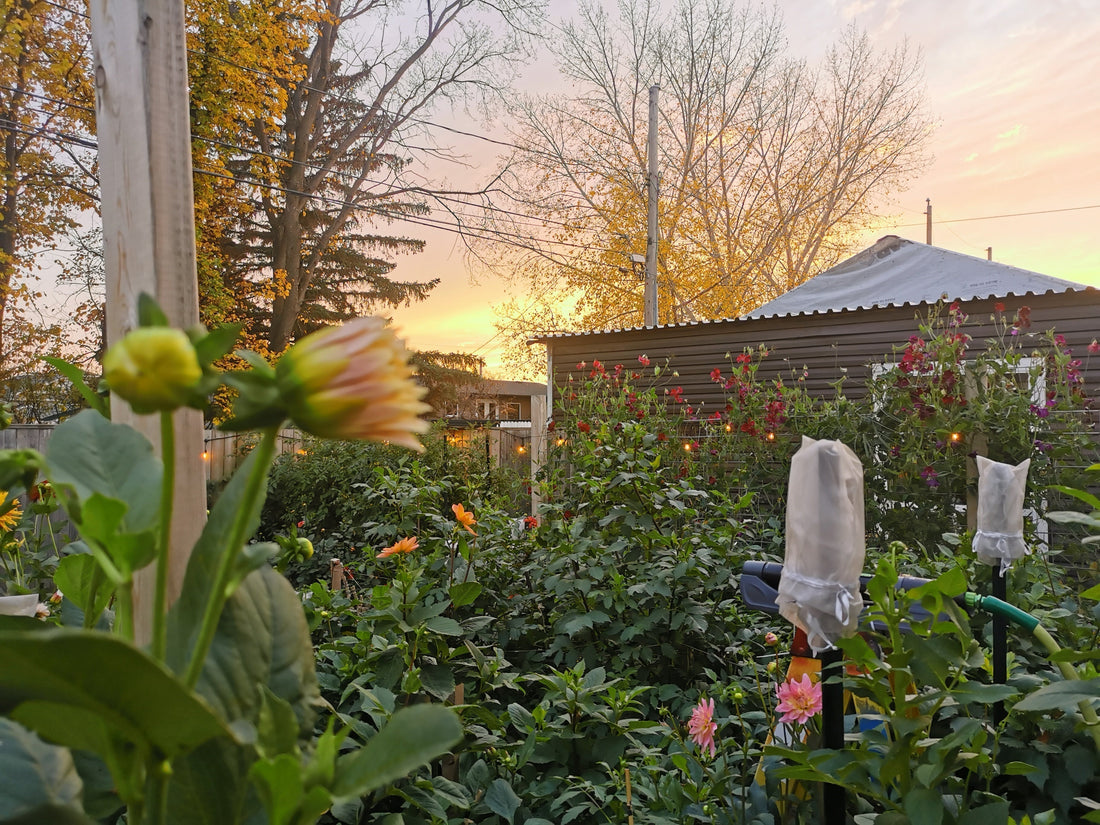
Planting + Growing Dahlias
If you're new to growing dahlias it can be overwhelming and you may feel unsure of the best way to ensure success. It is important to remember that each garden, farm, acreage, back yard, front yard, etc. is different. What works for me may not suit your growing space and vice versa. The great news is that the more often you do it the more you will learn what works for you each year! The majority of my dahlia growing experience comes from growing within city limits, I have minimal experience growing in a farm or acreage setting. That being said, the fundamental needs remain the same no matter where you are growing.
- Dahlias require at minimum 6 hours of sunshine and take anywhere from 12 to 16 weeks to bloom, an average of 3 months time.
- The smaller the bloom, the more flowers you will have. Don't expect the same amount of flowers from your Cafe au Lait plants as your pom pom varieties!
- They are heavy feeders and require consistent fertilizing from early on to ensure an abundance of blooms later in the season.
- Consistent watering is a must to keep plants hydrated and happy.
- Keep an eye out for pests year round. Unfortunately you're not the only one who wants to enjoy these beautiful blooms!
- Cut, cut, cut and cut again to keep plants blooming until frost.

Location. Dahlias require at minimum 6 hours of sunlight each day. It is important to note that plants that endure consistent, extreme heat in south facing gardens may require shade protection, especially when plants are young. A handful of days sprinkled over a few weeks early in the season are not cause to go all out and provide shade. Very rarely do we have such intense sunshine in the early days of summer but if it does happen don't be surprised to see your young plants wilting in the sunshine, they will bounce back once it cools down again.

photo | farm garden 2024, my first year growing dahlias outside of my yard gardens
Planting. Allow anywhere from 12 to 15 inches between plants to leave enough room for tuber growth throughout the season. I plant my tubers at a depth of 6 inches, you can go as low as 4 inches but I like the added wind protection that planting a bit deeper brings. Our part of Saskatchewan is considered a zone 3b in terms of hardiness. This means that our last day of frost generally falls on the May long weekend. In recent years we have experienced frost as late as the first and second weeks of June so keep an eye on the weather those first few weeks of planting regardless. There are two ways I plant/start my dahlias.
Early start indoors. If I have started tubers/cuttings early indoors I will plant those out May long weekend, even if the weather shows a potential for frost in the coming weeks. In that case I will simply cover my young plants with frost cloth, it hasn't let me down yet, you can also use flat bed sheets, just be sure you don't crush your plants.
Direct into ground. If I do not start the tubers early and instead plant them directly into the ground, I will plant them at the very end of April, or the first few days of May. If you are planting a large number of tubers I highly encourage this method, it's so much easier. The only exception to this are varieties that take their sweet time to bloom, I'm looking at you Black Jack and Cafe au Lait! Even if you aren't planting a large amount of tubers, this is a much less labour intensive way of starting plants. That being said, if space isn't an issue, you can still get a head start on getting those eyes to pop by pulling them out of storage in early April. Don't worry about potting them up individually this late into the Spring and choose the tray method instead. Visit my blog post on starting your dahlias for more information on this method. If you choose to plant your dahlias this way there are a couple of key points to remember.
-
- you must hold tubers in storage longer so be sure you're not compromising the health of your tubers to wait to plant
- do not water them until shoots appear above ground
- frost protection is only necessary once shoots are above ground
- you must plant as early as you can, consistently warm temps are necessary, it can vary each year, April 25th is the earliest I have ever planted with May 2nd being the latest

photo | young dahlia plants in my backyard garden, grown by direct planting in early Spring
Feeding your plants. Dahlias are extremely heavy feeders, you cannot skip the fertilizer on these beauties. We have a short growing season that can end anywhere from early September to November so be sure you're feeding your plants regularly to enjoy blooms as long as you can. My plants typically start to bloom mid July and are in full swing by the beginning of August.
Amend the soil. Each year I amend my dahlia beds before planting with a 2 to 3 inch layer of quality compost and manure. When planting I dust in a light layer of bone meal and scatter in alfalfa pellets. I wish I could give you precise measurements but I generally just scatter at will, you can't really mess this up. Both bone meal and alfalfa pellets are slow-release fertilizers that will benefit the plants as well as the soil health. They're inexpensive and easy to apply. Don't skip these steps if you want your plants to flourish.
-
- bone meal is rich in phosphorus which is excellent for tuber production, and produces strong stems and plenty of blooms. It also provides calcium which strengthens plant cell walls thus improving overall plant health and disease resistance. Bone meal is readily available at local garden stores year round and at big box stores during gardening season.
- alfalfa pellets are a slow-release source of nitrogen, phosphorus, and potassium, as well as other micronutrients and beneficial organic matter. I generally pick mine up at Early's in Saskatoon. And don't limit the use of alfalfa pellets to only your dahlias. I use it in all my gardening, vegetables and flowers. You can even create a "tea" by soaking the pellets for a few days and using it as a foliar spray in the garden and over lawns to provide nutrients directly to foliage.


photos above | alfalfa pellets purchased from Early's Farm & Garden Center in Saskatoon


photos | left, EZ-FLO Fertilizer Injector from Irrigation Direct Canada
right | Pro Mix Organic Water Soluble Fertilizer, any organic water soluble fertilizer will do

photo | back yard garden mulched with drip line system in place
Care and Maintenance. Once your dahlia plants are 8 to 12 inches tall, it is time to give them a trim by pinching back the main stem. When there are at least 4 leaf sets on the stem you want to either pinch off or trim the main stem back to a set of leaves, leaving at least 3 leaf sets on the main stem. This encourages branching which leads to many more blooms on strong and sturdy stems. I apologize that I don't have an image of this to share with you, but a quick Google search "how to pinch back dahlias" will lead to many visuals which should help.
Later in the season dahlias become very heavy and can topple over easily, especially in our prairie winds. It is important to stake your dahlia plants to prevent this. If you are growing dahlias in rows, utilizing stakes and the corral method with twine is the easiest way to keep them upright. If you have plants scattered throughout your gardens, individually staking each plant is the best way to keep them upright. I use a variety of metal t-posts and wooden 2x2 posts in my both my front and back garden beds.
Cut, cut and cut some more. Regular harvesting and dead-heading will keep your plants blooming right up until frost. While dahlias do not have a long vase life, when cut at the correct stage they will typically last from 5 to 7 days and are a beautiful addition to your home in the summer months. Even if you don't cut them to bring them indoors, be sure to dead-head spent blooms to encourage more growth.

photos | the dahlia garden bringing me all the joy as it grows

